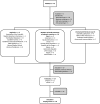Treatment of loiasis: a review of clinical management recommendations
- PMID: 40336051
- PMCID: PMC12057256
- DOI: 10.1186/s40249-025-01300-0
Treatment of loiasis: a review of clinical management recommendations
Abstract
Background: Loiasis affects more than 20 million residents of endemic regions in Central and West Africa causing chronic and often lifelong disease. Antifilarial treatment options for loiasis include diethylcarbamazine, ivermectin, and albendazole. Safe and effective management requires classifying patients into occult, microfilaremia, and hypermicrofilaremia categories. Treatment is complicated by the risk of severe adverse events, particularly encephalitis. Clear guidance on the appropriate use of antifilarial therapy is therefore of utmost importance. The aim of this review is to evaluate current treatment recommendations and assess their quality and consistency.
Methods: A scoping review was conducted to evaluate treatment recommendations for loiasis. The literature search encompassed multiple databases, including PubMed and specialized medical repositories, without restrictions on publication date or language. The approach included a systematic search with specific loiasis-related keywords and an unstructured search of guidelines from health ministries in endemic countries, along with grey literature and professional recommendations. Renowned tropical medicine textbooks were also consulted. Data were extracted with a detailed table collaboratively developed and reviewed by multiple researchers to ensure consistency and accuracy.
Results: The review identified 33 sources, consisting of nine guidelines, ten reviews, and 14 textbook excerpts. Publications reviewed spanned from 2001 to 2024 with no major innovations in treatment noted. Evidence quality was often low, with only two guidelines detailing their development process. Variability was particularly noted in dosage protocols for diethylcarbamazine, typically dosed incrementally. Ivermectin and albendazole were mostly noted as alternatives based on microfilarial levels. The common microfilarial threshold was 8000 microfilariae per millilitre, dictating treatment strategy adjustments. Adjunctive treatments, such as corticosteroids and antihistamines, were inconsistently proposed to mitigate side effects.
Conclusions: Inconsistencies between some recommendations were observed. There is an urgent need for internationally harmonized, evidence-based guidelines to address these inconsistencies, improve patient outcomes and minimize treatment-associated severe adverse events and fatalities.
Keywords: Loa loa; Guideline; Loiasis; Treatment.
© 2025. The Author(s).
Conflict of interest statement
Declarations. Ethics approval and consent to participate: Not applicable. Consent for publication: Consent from Franck Aurelien Ekoka Mbassi obtained for graphical abstract image. Competing interests: The authors declare that they have no competing interests.
Similar articles
-
Comparison of different drug regimens for the treatment of loiasis-A TropNet retrospective study.PLoS Negl Trop Dis. 2018 Nov 1;12(11):e0006917. doi: 10.1371/journal.pntd.0006917. eCollection 2018 Nov. PLoS Negl Trop Dis. 2018. PMID: 30383753 Free PMC article. Clinical Trial.
-
Encephalopathy in a patient with loiasis treated with albendazole: A case report.Parasitol Int. 2020 Apr;75:102006. doi: 10.1016/j.parint.2019.102006. Epub 2019 Oct 30. Parasitol Int. 2020. PMID: 31676328
-
Antifilarial treatment strategies: a systematic review and network meta-analysis.BMC Infect Dis. 2025 May 16;25(1):712. doi: 10.1186/s12879-025-11105-z. BMC Infect Dis. 2025. PMID: 40380307 Free PMC article. Review.
-
Identifying co-endemic areas for major filarial infections in sub-Saharan Africa: seeking synergies and preventing severe adverse events during mass drug administration campaigns.Parasit Vectors. 2018 Jan 31;11(1):70. doi: 10.1186/s13071-018-2655-5. Parasit Vectors. 2018. PMID: 29382363 Free PMC article.
-
Loa loa-does it deserve to be neglected?Lancet Infect Dis. 2014 Apr;14(4):353-7. doi: 10.1016/S1473-3099(13)70263-9. Epub 2013 Dec 12. Lancet Infect Dis. 2014. PMID: 24332895 Review.
References
-
- Ramharter M, Butler J, Mombo-Ngoma G, Nordmann T, Davi SD, Zoleko MR. The African eye worm: current understanding of the epidemiology, clinical disease, and treatment of loiasis. Lancet Infect Dis. 2024;24(3):e165–78. - PubMed
-
- Klion A. Clinical aspects: treatment of simple and complicated forms of loiasis of chapter. In: Akue JP, editor. Loa loa: latest advances in Loiasis research. 1st ed. Cham: Springer; 2024. p. 43–9.
-
- World Health Organization. Diethylcarbamazine Citrate 100mg tablets, (Eisai Co, Ltd), NT002. In: World Health Organization (eds.) WHO Public Assessment Reports, volume 4. 2016; Geneva: World Health Organization.
-
- Jacobsen KH, Andress BC, Bhagwat EA, Bryant CA, Chandrapu VR, Desmonts CG, et al. A call for loiasis to be added to the WHO list of neglected tropical diseases. Lancet Infect Dis. 2022;22(10):e299–302. - PubMed
Publication types
MeSH terms
Substances
LinkOut - more resources
Full Text Sources


